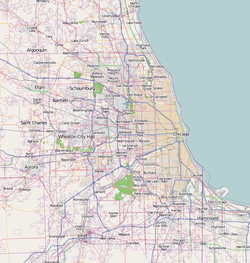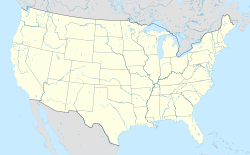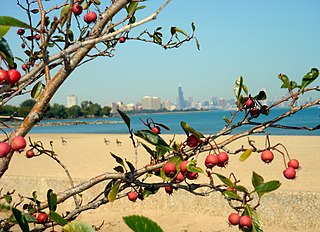
South Shore is one of 77 defined community areas of Chicago, Illinois, United States. A predominantly African-American neighborhood on the city's South Side, the area is named for its location along the city's southern lakefront. Although South Shore has seen a greater than 40% decrease in residents since Chicago's population peaked in the 1950s, the area remains one of the most densely populated neighborhoods on the South Side. The community benefits from its location along the waterfront, its accessibility to Lake Shore Drive, and its proximity to major institutions and attractions such as the University of Chicago, the Museum of Science and Industry, and Jackson Park.

Chatham is one of the 77 community areas of the city of Chicago, Illinois. It is located on the city's South Side. It includes the neighborhoods of Chatham-Avalon, Chatham Club, Chesterfield, East Chatham, West Chatham and the northern portion of West Chesterfield. Its residents are predominantly African American, and it is home to former Senator Roland Burris. Housing many city employees and other officials, Chatham has been a central area for Chicago's middle-class African Americans since the late 1950s.

Auburn Gresham, most commonly referred to simply as '"Gresham'", is one of the 77 official community areas of the city of Chicago, Illinois. It is located on the far south side of the city and was the original location of the South Side Irish Parade before it was relocated to the Beverly neighborhood farther southwest in the city.

Hyde Park is a neighborhood and historic district in Austin, Texas. Located in Central Austin, Hyde Park is defined by W. 38th Street to the south, W. 51st Street to the north, Duval Street to the east, and Guadalupe Street to the west. It is situated just north of the University of Texas and borders the neighborhoods of Hancock and North Loop.

The American System-Built Homes were modest houses designed by architect Frank Lloyd Wright. They were developed between 1912 and 1916 to fulfill his interest in affordable housing. Wright was devoted to the idea of providing beautiful yet affordable homes to the public. His firm produced over 960 drawings for the project, the largest number of drawings for any project in the Wright archives. The designs were standardized, and customers could choose from seven models. Because of this standardization, the lumber could be precut at the factory, thereby cutting down on both waste and the amount of skilled labor needed for construction. The buildings are often termed prefabricated homes, but they were not, since no parts of the homes were constructed off-site. The lumber was cut at the factory, packaged along with all other components, and delivered to the work site for construction. Some are located in a federal historic district in Milwaukee, Wisconsin, and others have been designated Chicago Landmarks in Chicago, Illinois.
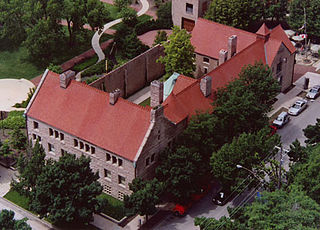
Prairie Avenue is a north–south street on the South Side of Chicago, which historically extended from 16th Street in the Near South Side community area of Chicago in Cook County, Illinois, United States, to the city's southern limits and beyond. The street has a rich history from its origins as a major trail for horseback riders and carriages. During the last three decades of the 19th century, a six-block section of the street served as the residence of many of Chicago's elite families and an additional four-block section was also known for grand homes. The upper six-block section includes part of the historic Prairie Avenue District, which was declared a Chicago Landmark and added to the National Register of Historic Places.

The Garden Homes Historic District is a residential historic district located in the Chatham neighborhood of the South Side, Chicago, Illinois. The district includes 152 residential buildings, 88 of which are contributing buildings, built in 1919-20 as Chicago's first large housing project. The newly formed Chicago Housing Association, a group of 22 prominent Chicago businessmen that included J. Ogden Armour, Charles H. Wacker, and William Wrigley, Jr., planned the homes as an affordable housing project for working-class Chicagoans. At the time, the city was suffering from a post-World War I housing crisis, and many of its working-class residents lived in tenements or other unlivable housing. Architect Charles Sumner Frost designed the homes, which were mainly brick cottages and stucco duplexes. The houses were built on unusually large lots for the time; the extra land was designed to serve as garden space for residents.
The Adams Street Historic District in Franklin, Tennessee consists of properties at 1112-1400 Adams, 1251-1327 Adams St., and 304-308 Stewart St. It is a 14-acre (5.7 ha) historic district was listed on the National Register of Historic Places in 2000 and is one of seven local historic districts in the city of Franklin.
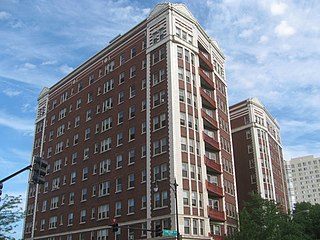
The East Park Towers are a historic apartment building at 5236-5252 S. Hyde Park Boulevard in the Hyde Park neighborhood of Chicago, Illinois. The building was constructed in 1922-23 during a period of residential growth in Hyde Park. While it had no guest rooms, the apartments offered similar amenities to an apartment hotel, such as housekeeping service. Apartment hotels were popular as part-time housing for wealthy workers, as they combined the amenities of in-home service with the affordability of apartments, and the East Park Towers were one of several such apartments built in Hyde Park at the time. Architect William P. Doerr designed the building in the Georgian Revival style; his design included terra cotta belt courses and quoins and Palladian windows on the first floor.
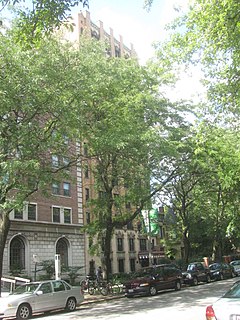
The Poinsettia Apartments are an apartment hotel at 5528 S. Hyde Park Boulevard in the Hyde Park neighborhood of Chicago, Illinois. Built in 1929, the building was the last of several apartment hotels built in Hyde Park during a period of residential development in the late 1910s and 1920s. Apartment hotels were popular among wealthier workers in the city at the time, as they combined the amenities and prestige of hotels with the affordability of apartments. The Poinsettia Apartments were both the smallest of the Hyde Park apartment hotels and the only building designed in the Spanish Colonial Revival style. Its design features pilasters spanning the height of the building, terra cotta ornamentation, and decorative window surrounds on the first two floors.

The South Park Manor Historic District is a residential historic district in the Greater Grand Crossing neighborhood of Chicago, Illinois. The district includes 263 Chicago bungalows built between 1915 and 1927. At the time, single-family homeownership was becoming broadly accessible to Chicagoans, and the bungalow was a popular choice for dense urban housing. The bungalows in the district were designed by several developers, but the district has a consistent appearance nonetheless. The use of a single home type throughout provided uniformity to the neighborhood, while stylistic variations such as the placement of dormers and porches gave each house its own character. The developers also gave their homes spacious lawns and private backyards to preserve green space in an urban setting.

The South Shore Bungalow Historic District is a residential historic district in the South Shore neighborhood of Chicago, Illinois. The district contains 229 Chicago bungalows and twenty other residential buildings built between 1911 and 1930. As homes became more accessible to families in early 20th century Chicago, thousands of bungalows were built to meet the housing demand. While bungalows were affordable mainly due to their uniform designs, their builders changed details such as color and entrance position to keep each home unique. The South Shore bungalows were among the first built in the city, as South Shore was already a popular neighborhood when the bungalow boom began, and the district contains many 1910s stucco bungalows; however, every bungalow built after 1917 is brick.

The West Chatham Bungalow Historic District is a residential historic district in the Chatham neighborhood of Chicago, Illinois. The district includes 283 Chicago bungalows built between 1913 and 1930 along with a smaller number of other residential buildings. As Chicago grew in the early 20th century and homeownership became more accessible, the bungalow arose as a popular and affordable house design, and tens of thousands of them were built in the city. Chatham, an outlying neighborhood on the city's South Side, benefited from this housing boom, as its transit connections made the area an attractive choice for new housing. The West Chatham bungalows are all brick and feature similar designs, giving the neighborhood a uniform appearance; however, decorative features such as patterned brickwork provide diversity among the homes.

The Brainerd Bungalow Historic District is a residential historic district in the Brainerd neighborhood of the Washington Heights community area of Chicago, Illinois. The district includes 527 Chicago bungalows built between 1915 and 1931 and a small number of other residential buildings. Brainerd, an outlying neighborhood of Chicago, was developed in the 1910s and 1920s as the increasing accessibility of homeownership spurred new home construction in underpopulated areas of the city. As bungalows were affordable to construct, they became popular in newly developed neighborhoods, and tens of thousands of them were built throughout the city. While 42 different architects designed Brainerd's bungalows, the neighborhood has a consistent appearance nonetheless, as the affordability of bungalows came in part from how easy the design was to duplicate; however, architects used color and detail work to give each home a unique design.

The Schorsch Irving Park Gardens Historic District is a residential historic district in the Dunning neighborhood of Chicago, Illinois. The district includes 255 buildings, all but three of which are Chicago bungalows. In the early twentieth century, tens of thousands of Chicago bungalows were built in the city; as homeownership became more accessible to working-class Chicagoans, demand for housing increased, and bungalows were an affordable way of meeting this demand due to their relatively uniform design. The bungalows in the district were largely built either between 1917 and 1918 or between 1922 and 1926. Unlike Chicago's other bungalow-dominated neighborhoods, which often had several different developers, developer Albert J. Schorsch built every bungalow in the district, and architech Ernest N. Braucher designed all of them. To add diversity to a neighborhood made up of only one style of house, the two men varied the homes' roof shapes, colors, and dormers.

The Wrightwood Bungalow Historic District is a residential historic district encompassing the 4600 and 4700 blocks of Wrightwood Avenue in the Belmont Cragin neighborhood of Chicago, Illinois. The district includes 58 houses built between 1916 and 1926, 55 of which are Chicago bungalows. As homeownership became more accessible in early twentieth century Chicago, the bungalow became popular as an affordable home design, and tens of thousands of the houses were built throughout Chicago. Like many of Chicago's bungalow-heavy neighborhoods, both the district and the Belmont Cragin neighborhood in general saw little residential development before the bungalow boom; however, the area was much more industrial than most similar neighborhoods. While several developers built bungalows in the district, the Stolzner Construction Company built over half of them, including every bungalow on the 4600 block. The company's architect, Joseph Klafter, differentiated the bungalows by changing details such as their color, entrance position, and dormer design.

The Rogers Park Manor Bungalow Historic District is a residential historic district in the West Ridge neighborhood of Chicago, Illinois. The district includes 329 buildings, 247 of which are Chicago bungalows built in the 1920s. As homeownership became more accessible to working-class Chicagoans in the early twentieth century, bungalows became an affordable and popular style due to their easily replicable design, and tens of thousands of the houses were built throughout Chicago. The Rogers Park Manor area was typical of new bungalow neighborhoods, as it was an underdeveloped outlying neighborhood near the city's northern edge. The bungalows in Rogers Park Manor were built by several different developers and architects, which led to variation in the size and shape of the homes despite their similar designs.

The Falconer Bungalow Historic District is a residential historic district in the Belmont Cragin neighborhood of Chicago, Illinois. The district comprises 348 Chicago bungalows built from 1915 to 1931. As homeownership became more affordable in early twentieth century Chicago, the bungalow became popular as an affordable and easily replicable home style, and tens of thousands of the homes were built throughout the city. While more industrial than average, the Belmont Cragin area was otherwise typical of the new bungalow neighborhoods, as it was an underdeveloped area on the outskirts of the city. Laughlin Falconer, for whom the district is named, owned and farmed on the land before dividing it and selling it to developers in 1913. Architects Ernest Braucher and Johan F. Knudson designed most of the bungalows in the district; both architects frequently gave their houses full-length, open-air front porches, and the district has one of the city's most significant collections of open front porch bungalows as a result.

The Talman West Ridge Bungalow Historic District is a residential historic district in the West Ridge neighborhood of Chicago, Illinois. 181 of the district's 272 buildings are either brick Chicago bungalows or older stucco bungalows built from 1919 to 1930. As homeownership became more affordable in early twentieth century Chicago, the bungalow became popular for its easily and cheaply replicated design, and tens of thousands of the homes were built throughout the city. West Ridge, a lightly developed area on Chicago's northern border, was typical of the neighborhoods that were dominated by new bungalows. While a variety of developers and architects built the district's bungalows in distinctive fashions, the homes' similar designs and consistent setbacks from the street give the district a cohesive appearance.

The Portage Park Bungalow Historic District is a residential historic district in the Portage Park neighborhood of Chicago, Illinois. The district includes 225 buildings, 189 of which are brick Chicago bungalows built between 1915 and 1930. As homeownership became broadly accessible to Chicagoans in the early twentieth century, the bungalow emerged as a popular and affordable house design, and tens of thousands of the homes were built throughout Chicago. Portage Park was one of the many outlying neighborhoods of Chicago which grew dramatically as a result of the housing boom; new residents were also attracted to the neighborhood's eponymous park. While the district was developed by many different builders and architects, the use of a single home type with uniform setbacks from the street gives the neighborhood a consistent appearance.

